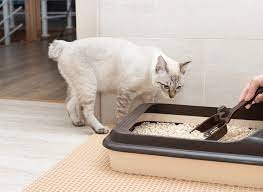Cat owners should always be careful when handling pet waste. Kitty litter must not be flushed down the toilet because it is mainly made of recycled products. The most common litter constituent, “Bentonite,” can absorb fluids up to fifteen times its original weight.
Suppose you flush it down the toilet; this component can hugely swell up and block the sewage pipes, including those of your home. Clogged pipes can get messy, cause leakage, stink, and hinder flushing. Also, kitty litter is dangerous for the environment and people as it is a source of various infectious diseases.
Dispose of the waste correctly and bathe your kitty as and when needed, so it stays happy and healthy. At the same time, consider being prepared with cat insurance so that dealing with unanticipated health troubles is much easier.
Pet insurance makes providing timely medical help possible without you having to take on the entire financial stress during dire health scenarios. Contemplate purchasing a policy to guard your pet and potentially save on unexpected vet bills too. Meanwhile, read this article to learn how to dispose of cat litter safely.
Regardless of the type of kitty litter you use, it is essential to follow the right steps to get rid of it. This is important to protect the ecosystem and the health of the household members.
#1
Some cat owners toss the used kitty litter into the trash can when replacing the litter box contents with fresh litter. It is not a proper way to dispose of litter; cat parents can instead throw the pee and poop loaded litter into a heavy-duty bag and seal it tightly to prevent messes, odors, and toxic bacteria from escaping. If all you have is regular trash bags, then fill the bag with kitty litter, tie a tight knot, and put it in another bag of the same kind to avoid spillage due to tears. Don’t ever mix it with wet garbage collected at home.
#2
Have an exclusive trash can with a tight lid to store the dirty litter-filled and sealed bags if you are used to emptying the litter box daily. Keep it in a different place, not next to your kitchen trash can. Scoop the box often but pay extreme attention to health and hygiene. This way, the household and your fur family will be adequately protected.
#3
Flushing down the toilet, as said before, isn’t a great idea. Even if it is an eco-friendly clumping litter, it can damage your plumbing system. Harmful bacteria and parasites like Toxoplasma Gondii can rapidly spread in the water supply and sewer system and possibly put many lives at risk. Flushing is an easy but not the right way to dispose of cat litter as it causes environmental contamination.
#4
Eco-friendly litter can be used in your garden because they are biodegradable. They are made from items like wheat, corn, grass, wood, paper, and walnuts and can be used as garden compost. However, don’t use your cat’s litter as a garden fertilizer on fruits and vegetable plants, even if you have scooped out the waste. It is worth noting that clay litter isn’t biodegradable and cannot be composted.
#5
Doing a complete litter change? Then use an organic bag when scooping the litter because even if it goes to a landfill, the bag and its contents don’t remain the same over the years; they will decompose and merge with the soil.
Correctly disposing of dirty cat litter ensures the safety of people, animals, and the environment at large. It helps prevent the spread of deadly disease-causing bacteria and parasites in cat poop. Still, it helps to consider purchasing cat insurance because not all health issues are avoidable.
Pet insurance helps with testing, treatment, and medication costs during distressing health situations and medical emergencies. So, why not contemplate buying a policy?


